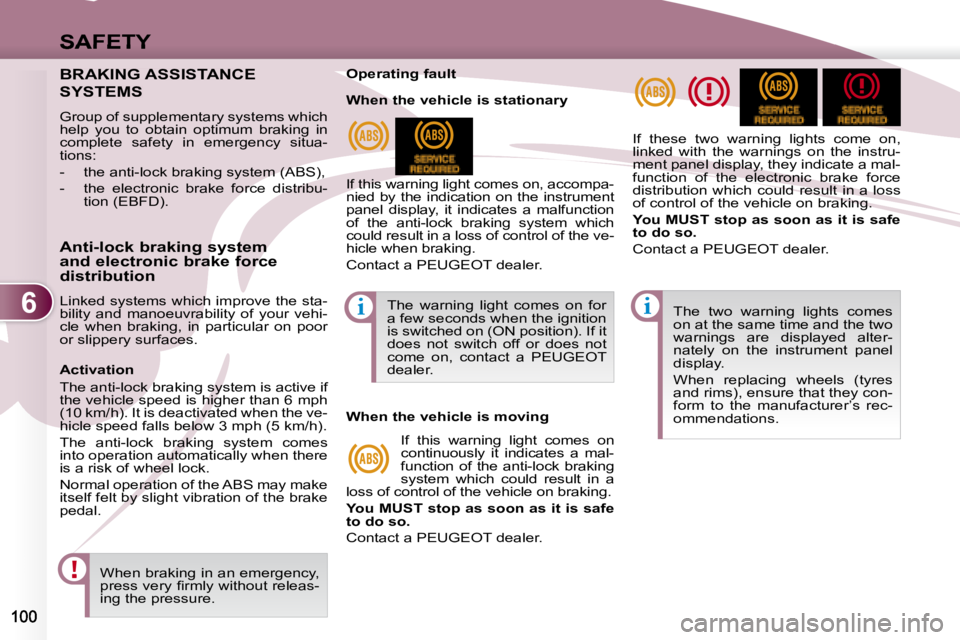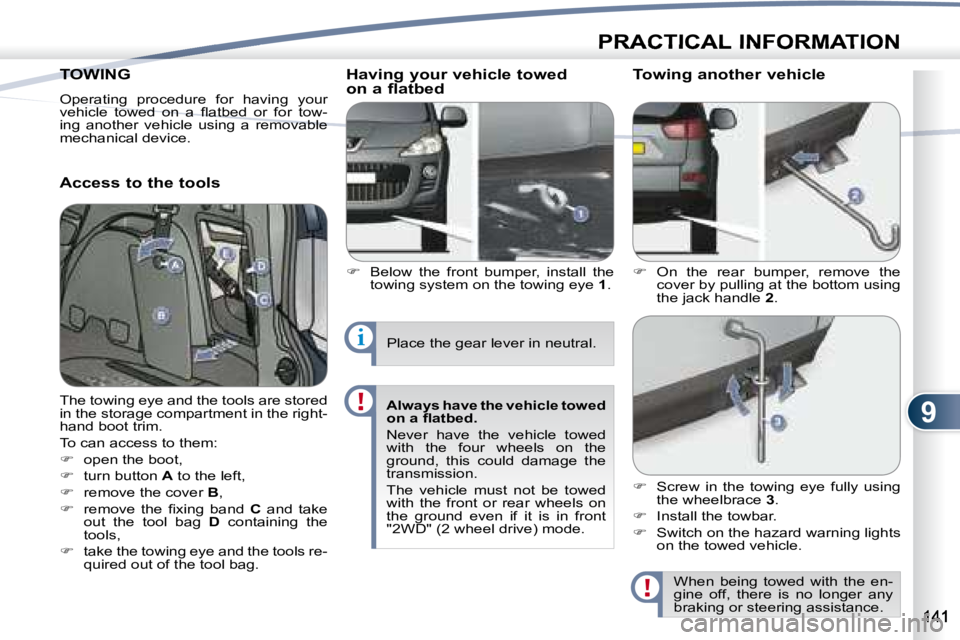Page 110 of 221

6ii
SAFETY
BRAKING ASSISTANCE
SYSTEMS
Group of supplementary systems which
help you to obtain optimum braking in
complete safety in emergency situa-
tions:
- the anti-lock braking system (ABS),
- the electronic brake force distribu-tion (EBFD).
Anti-lock braking system
and electronic brake force
distribution
Linked systems which improve the sta-
bility and manoeuvrability of your vehi-
cle when braking, in particular on poor
or slippery surfaces.
When braking in an emergency,
�p�r�e�s�s� �v�e�r�y� �fi� �r�m�l�y� �w�i�t�h�o�u�t� �r�e�l�e�a�s�-
ing the pressure. The two warning lights comes
on at the same time and the two
warnings are displayed alter-
nately on the instrument panel
display.
When replacing wheels (tyres
and rims), ensure that they con-
form to the manufacturer’s rec-
ommendations.
Operating fault
If this warning light comes on, accompa-
nied by the indication on the instrument
panel display, it indicates a malfunction
of the anti-lock braking system which
could result in a loss of control of the ve-
hicle when braking.
Contact a PEUGEOT dealer.
If these two warning lights come on,
linked with the warnings on the instru-
ment panel display, they indicate a mal-
function of the electronic brake force
distribution which could result in a loss
of control of the vehicle on braking.
You MUST stop as soon as it is safe
to do so.
Contact a PEUGEOT dealer.
Activation
The anti-lock braking system is active if
the vehicle speed is higher than 6 mph
(10 km/h). It is deactivated when the ve-
hicle speed falls below 3 mph (5 km/h).
The anti-lock braking system comes
into operation automatically when there
is a risk of wheel lock.
Normal operation of the ABS may make
itself felt by slight vibration of the brake
pedal. The warning light comes on for
a few seconds when the ignition
is switched on (ON position). If it
does not switch off or does not
come on, contact a PEUGEOT
dealer.
When the vehicle is stationary
When the vehicle is moving
If this warning light comes on
continuously it indicates a mal-
function of the anti-lock braking
system which could result in a
loss of control of the vehicle on braking.
You MUST stop as soon as it is safe
to do so.
Contact a PEUGEOT dealer.
Page 137 of 221
9
i
PRACTICAL INFORMATION
CHANGING CHANGING A BULB
Operating procedure for replacing a
faulty bulb with a new bulb. Handle the bulbs using a dry
cloth.
Do not clean the headlamps
using a dry or abrasive cloth,
or using detergent or solvent
products, use a sponge and
soapy water. In certain climatic conditions
(low temperature, humidity),
t
he
presence of condensation on
the inside of the headlamp
glass is normal ; it disappears a
few minutes after the lights are
switched on.
Front lights
Blown bulb
Refer to the appropriate procedure to
change the corresponding bulb.
1. Direction indicators
(PY 21 W - 21 W).
2. Dipped headlamps (H11 - 55 W)
or xenon bulb (D2S - 35 W).
3. Side lights (W 5 W - 5 W).
4. Main beam headlamps
(H7 - 55 W).
5. Front fog lamps
(H11 - 55 W). WARNING: RISK OF
ELECTROCUTION
Xenon bulbs must be replaced by a
PEUGEOT dealer.
Page 152 of 221

9
i
PRACTICAL INFORMATION
TOWING TOWING
Operating procedure for having your
�v�e�h�i�c�l�e� �t�o�w�e�d� �o�n� �a� �fl� �a�t�b�e�d� �o�r� �f�o�r� �t�o�w�-
ing another vehicle using a removable
mechanical device.
Access to the tools Having your vehicle towed
on a flatbed
� Below the front bumper, install the
towing system on the towing eye 1 .
� On the rear bumper, remove the
cover by pulling at the bottom using
the jack handle 2 .
Towing another vehicle
The towing eye and the tools are stored
in the storage compartment in the right-
hand boot trim.
To can access to them:
� open the boot,
� turn button A to the left,
� remove the cover B ,
� � � �r�e�m�o�v�e� �t�h�e� �fi� �x�i�n�g� �b�a�n�d� � C and take
out the tool bag D containing the
tools,
� take the towing eye and the tools re-
quired out of the tool bag.
When being towed with the en-
gine off, there is no longer any
braking or steering assistance.
Place the gear lever in neutral.
Always have the vehicle towed
�o�n� �a� �fl� �a�t�b�e�d�.
Never have the vehicle towed
with the four wheels on the
ground, this could damage the
transmission.
The vehicle must not be towed
with the front or rear wheels on
the ground even if it is in front
"2WD" (2 wheel drive) mode.
� Screw in the towing eye fully using
the wheelbrace 3 .
� Install the towbar.
� Switch on the hazard warning lights
on the towed vehicle.